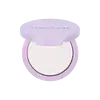What's inside
What's inside
 Key Ingredients
Key Ingredients

 Benefits
Benefits

 Concerns
Concerns

 Ingredients Side-by-side
Ingredients Side-by-side

Mica
Cosmetic ColorantKaolin
AbrasiveSilica
AbrasiveAluminum Starch Octenylsuccinate
AbsorbentMethyl Methacrylate Crosspolymer
Pentaerythrityl Tetraisostearate
EmollientCellulose
AbsorbentSqualane
EmollientSynthetic Wax
AbrasiveLauroyl Lysine
Skin ConditioningSorbitan Isostearate
EmulsifyingTrihydroxystearin
Skin ConditioningSilica Dimethyl Silylate
EmollientDimethicone
EmollientDicaprylyl Carbonate
EmollientMagnesium Myristate
Glyceryl Caprylate
Emollient1,2-Hexanediol
Skin ConditioningMethicone
EmollientEthylhexylglycerin
Skin ConditioningTriethoxycaprylylsilane
Iron Oxides
CI 77007
Cosmetic ColorantCI 15850
Cosmetic ColorantCI 19140
Cosmetic ColorantMica, Kaolin, Silica, Aluminum Starch Octenylsuccinate, Methyl Methacrylate Crosspolymer, Pentaerythrityl Tetraisostearate, Cellulose, Squalane, Synthetic Wax, Lauroyl Lysine, Sorbitan Isostearate, Trihydroxystearin, Silica Dimethyl Silylate, Dimethicone, Dicaprylyl Carbonate, Magnesium Myristate, Glyceryl Caprylate, 1,2-Hexanediol, Methicone, Ethylhexylglycerin, Triethoxycaprylylsilane, Iron Oxides, CI 77007, CI 15850, CI 19140
Mica
Cosmetic ColorantSilica
AbrasiveCapryloyl Glycerin/Sebacic Acid Copolymer
Skin ConditioningLauroyl Lysine
Skin ConditioningGlyceryl Stearate
EmollientOctyldodecanol
EmollientSimmondsia Chinensis Seed Oil
EmollientPentylene Glycol
Skin ConditioningGlycerin
HumectantGlyceryl Caprylate
EmollientPotassium Sorbate
PreservativeBambusa Arundinacea Stem Powder
AbrasivePassiflora Edulis Seed Oil
EmollientGlyceryl Undecylenate
EmollientWater
Skin ConditioningStearic Acid
CleansingCandelilla Cera
EmollientXanthan Gum
EmulsifyingSodium Phytate
Cetearyl Olivate
Tocopherol
AntioxidantSorbitan Olivate
EmulsifyingHonokiol
AntioxidantPaeonia Officinalis Flower Extract
TonicHelianthus Annuus Seed Oil
EmollientVitis Vinifera Seed Extract
AntimicrobialCI 77491
Cosmetic ColorantCI 77492
Cosmetic ColorantCI 77499
Cosmetic ColorantMica, Silica, Capryloyl Glycerin/Sebacic Acid Copolymer, Lauroyl Lysine, Glyceryl Stearate, Octyldodecanol, Simmondsia Chinensis Seed Oil, Pentylene Glycol, Glycerin, Glyceryl Caprylate, Potassium Sorbate, Bambusa Arundinacea Stem Powder, Passiflora Edulis Seed Oil, Glyceryl Undecylenate, Water, Stearic Acid, Candelilla Cera, Xanthan Gum, Sodium Phytate, Cetearyl Olivate, Tocopherol, Sorbitan Olivate, Honokiol, Paeonia Officinalis Flower Extract, Helianthus Annuus Seed Oil, Vitis Vinifera Seed Extract, CI 77491, CI 77492, CI 77499
 Reviews
Reviews

Ingredients Explained
These ingredients are found in both products.
Ingredients higher up in an ingredient list are typically present in a larger amount.
Glyceryl Caprylate comes from glycerin and caprylic acid, a fatty acid from coconut. It has emollient and emulsifier properties.
As an emollient, it helps hydrate your skin. Emollients work by creating a barrier on your skin to trap moisture in, helping to keep your skin soft and smooth.
On the other hand, emulsifiers prevent ingredients (such as oil and water) from separating.
Learn more about Glyceryl CaprylateThis ingredient comes from a fatty acid (lauric acid) and amino acid (lysine). It is used to add a silky feel to cosmetics.
According to a manufacturer, its fatty acid base leaves a silky feeling on the skin. It also has emollient properties because of this. Emollients help soften skin by preventing water from evaporating.
Lauroyl lysine is barely soluble in water.
Learn more about Lauroyl LysineMica is a naturally occurring mineral used to add shimmer and color in cosmetics. It can also help improve the texture of a product or give it an opaque, white/silver color.
Serecite is the name for very fine but ragged grains of mica.
This ingredient is often coated with metal oxides like titanium dioxide. Trace amounts of heavy metals may be found in mica, but these metals are not harmful in our personal products.
Mica has been used since prehistoric times throughout the world. Ancient Egyptian, Indian, Greek, Roman, Aztec, and Chinese civilizations have used mica.
Learn more about MicaSilica, also known as silicon dioxide, is a naturally occurring mineral. It is used as a fine, spherical, and porous powder in cosmetics.
Though it has exfoliant properties, the function of silica varies depending on the product.
The unique structure of silica enhances the spreadability and adds smoothness, making it a great texture enhancer.
It is also used as an active carrier, emulsifier, and mattifier due to its ability to absorb excess oil.
In some products, tiny microneedles called spicules are made from silica or hydrolyzed sponge. When you rub them in, they lightly polish away dead skin layers and enhance the penetration of active ingredients.
Learn more about Silica